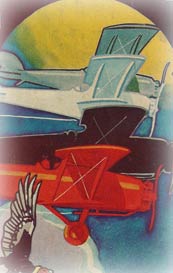|
WILLIAM EDWARD BOEING AND THE BOEING AIRPLANE COMPANY
There were at least 315 landings by Boeing aircraft across the six Web sites that comprise Delta Mike Airfield, Inc. The landings represented both military (286 landings) and civil aviation sectors. That the military sector claimed the majority of landings is not a surprise, since both the U.S. Army and Navy/Marines used Boeing types. For fully a third of all the Boeing landings, the aircraft were not identified by registration number. All but two of those were military craft. Military pilots seemed less inclined to record airplane numbers.
Of the 185 military Boeings that were identified by number, 55 carried Navy numbers and 130 were with the Army. The Navy flew mostly F-2, F-3 and F-4 models; the Army mostly P-12, PW-9 and P-26 models. At least one Marine Corps airplane was flown by a Medal of Honor winner, C. Frank Schilt.
The Boeing Airplane Company was founded by its namesake, William Edward Boeing. For a few years early in the 20th century, Boeing crafted two small float planes, mostly for his own learning and use. On July 15, 1916, he incorporated his airplane manufacturing business as Pacific Aero Products Co. About a year later, he changed the name to the Boeing Airplane Company. Below, from Popular Aviation (PA) magazine, April, 1927, is a portrait of Boeing. This portrait was taken shortly after he founded his air transport company subsidiary.
William Boeing as President of Boeing Air Transport Company, 1927 (Source: PA)
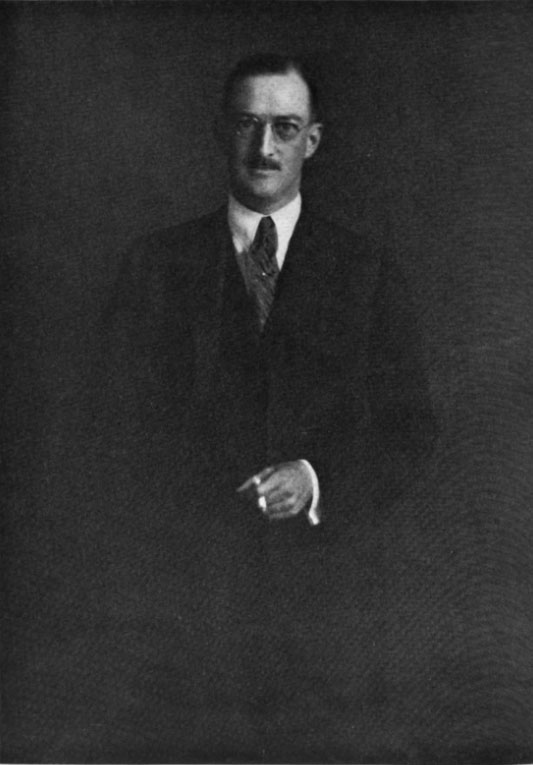 |
Among the civil Boeing types that landed were Models 40, 80, 95 and 100. Some were flown commercially for airmail and at least one was owned by TWA. Others were privately owned, such as the Boeing 100 NC872H flown by Davis-Monthan pilot Milo Burcham. Clover Field pilot Howard Hughes also flew and raced a Model 100, NC247K (not a Register airplane).
William Boeing, Popular Aviation, May, 1934 (Source: PA)
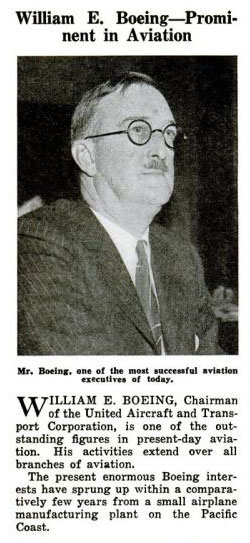 |
Boeing and his company have a major Web presence, with over 36-million Google hits as of the upload date of this page. One example is at left from Popular Aviation, May, 1934. Barely two decades after he founded his original company, "His activities extend over all branches of aviation." Just seven years later, his bombers would have major effects on Axis powers in the form of his B-17 and B-29.
The U.S. Census for 1900, compiled June 6th, placed Boeing (age 18) in Albemarle County, VA living with stepfather Frederick Ousley (37), a farmer, mother Marie M. (38), sister Caroline (15) and housekeeper Mary S. Carr. He was cited as a "student." He was a student at Yale at the time.
At age 28, according to the 1910 U.S. Census, Boeing was living in Seattle, WA as a boarder with 23 other tenants at 1120 Madison Street. The Google Earth view of that address looks like new construction today. His occupation was identified as "Manager" in the "Lumberman" industry. We find him at this time building his fortune in lumber, about six years before he founded the Boeing Airplane Company.
At age 38, the 1920 Census placed Boeing at Stewart, WA, single, and working as a "Manufacturer" of "Airplanes." He lived with a servant, a laundress and a chauffeur. His home was not mortgaged.
The 1930 U.S. Census, compiled April 7th, records Boeing and his family living at 117 Highlands Road, Seattle, WA. He lived with his wife, Bertha (age 39), two stepsons (ages 17 & 13), a son, William E, Jr. (7), and nine multinational servants. He owned his home, which had a recorded value of $100,000.
The contemporary Boeing Company Web site provides a series of narratives that nicely and clearly describe the history of the company. The narratives place the history of the company within the contemporary business, and include the companies that ultimately merged to become Boeing, McDonnell, North American, Douglas and Hughes. A biography of Boeing is at the link. Boeing was born October 1, 1881. He died September 28, 1956. IN 1966, he was memorialized in the Aviation Hall of Fame in Dayton, Ohio, "for outstanding contributions to aviation by his successful organization of a network of airline routes and the production of vitally important military and commercial aircraft."
---o0o---
SOME BOEING AIRCRAFT OF THE REGISTERS
These are only a few examples of the hundreds of Register entries of Boeing aircraft.
Boeing O2B-1 A-6908, flown by the U.S. Marine Corps, is below. Please follow the link for more information about the airplane and its pilot.
Boeing O2B-1, A-6908, Late 1920s (Source: Link)
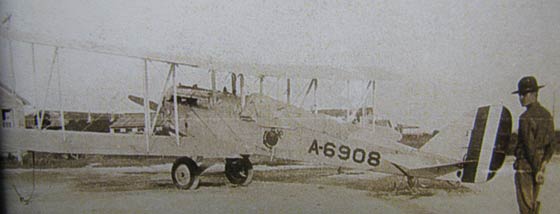 |
Boeing P-12-B 29-333, Date Unknown (Source: Link)
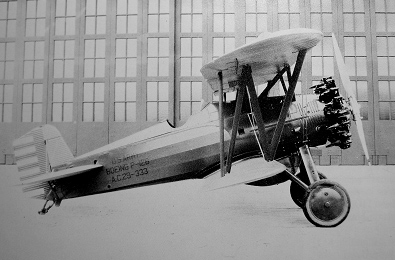 |
Boeing P-12-B 29-333, flown in U.S. Army markings, is at right. Please follow the link for more information about the airplane.
The Boeing Monomail NC10225 is below. It was originally introduced in 1931 as the Model 200, a cargo-only, Pratt & Whitney Hornet-powered airplane. Modified to a Model 221, in 1931 the Boeing Air Transport Company flew the airplane on its San Francisco to Chicago route. Please follow the link for more information about the airplane.
Boeing Monomail NC10225 (Source: Link)
 |
The Boeing Model 80-A, NC233M, is below. It was a large, tri-motor biplane operated by the Standard Oil Company of California. Please follow the link for more information about the airplane.
Boeing Model 80-A (Source: Link)
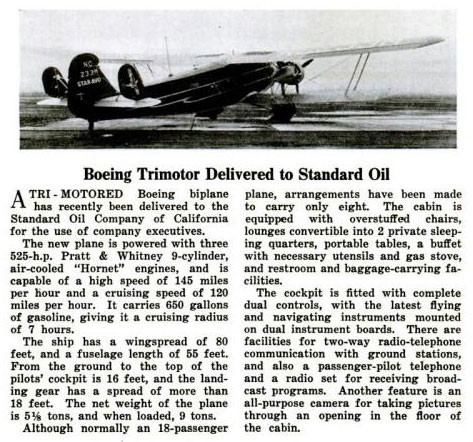 |
---o0o---
THIS PAGE UPLOADED: 09/14/14 REVISED:
|

